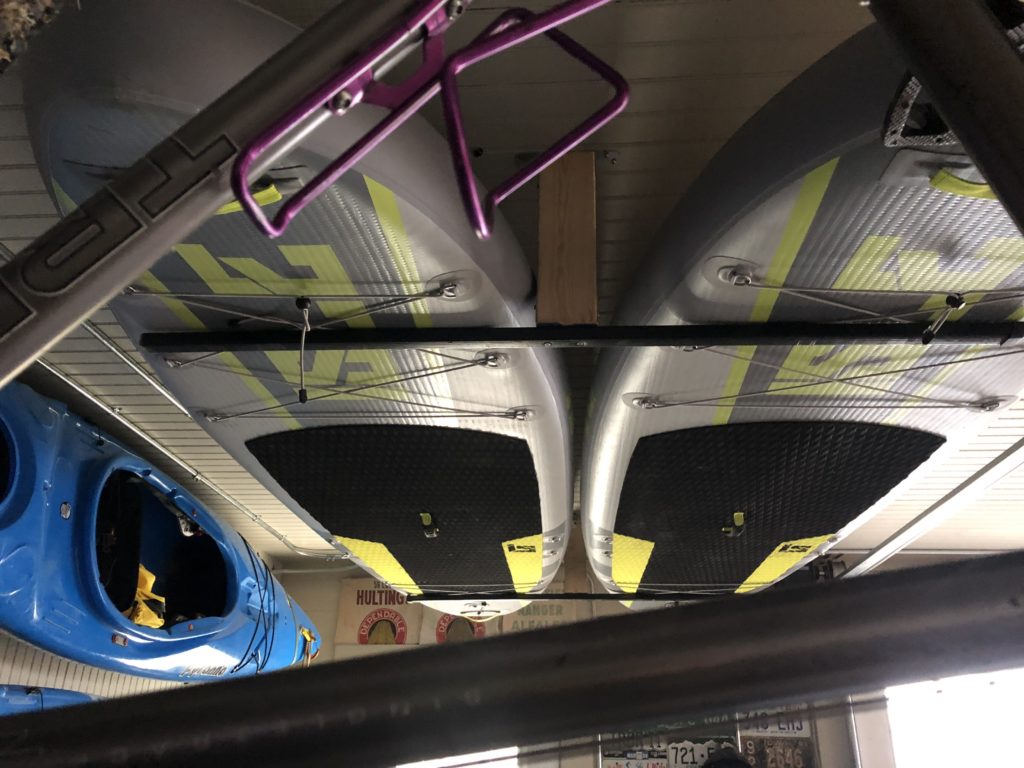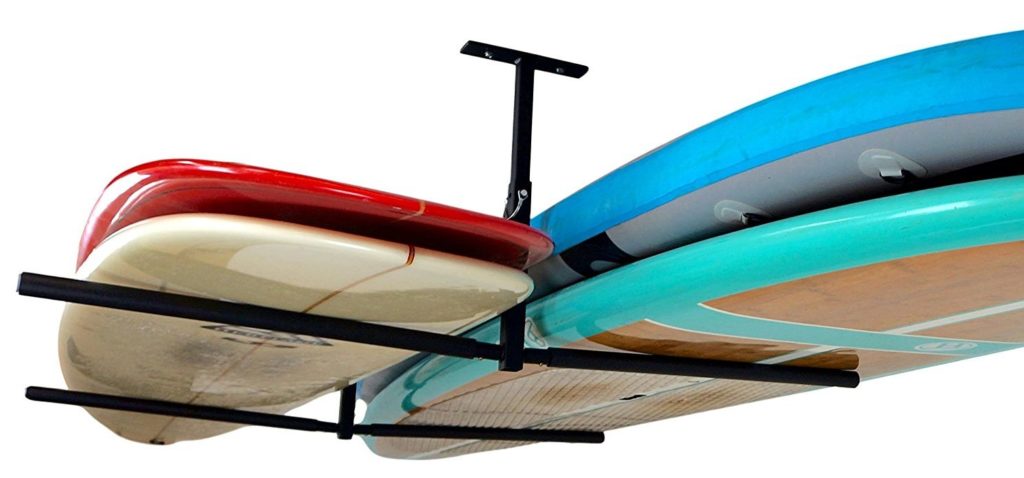SUP Storage Solution
A Simple Overhead Storage for Standup Paddle Boards & Surfboards
Build this overhead rack for $0 – $15.00
Standup paddle boards are a great way to enjoy the water and get in a workout but storage can be tough as they can be quite long and bulky. Its best to keep them out of the way so they don’t get damaged or cause damage to your other gear. Some people like wall storage in their garage or basement, others keep them outside. We have inflatable boards so to save space, storage is as simple as letting out the air and rolling them up. We love that versatility of the inflatable boards and they are insanely strong too as the material is the same as a whitewater raft. However, for convenience and to save time we tend to leave the boards inflated and just throw them on the roof of the truck when we want to paddle. We had been putting them on the roof of a car that we were working on in the garage but when that project came to an end we needed another solution. We looked for a commercially sold hanging board rack and found several options. Store Your Board has a really nice looking hanging rack available on Amazon for $75.00-100.00. We love this design and if you are short on time, just buy this. Getting your boards safely up and out of the way is worth it and the best part about his rack, is the adjustable height or perhaps we should say “adjustable drop”.
We almost bought this rack and I’m sure it would be sweet, but after looking around the shop and taking some meaurements, we came up with a simple solution similar to the Store Your Board rack. Our is not adjustable height but it doesn’t matter as we fabricated it to the exact size we needed. You can probably make something similar to this from stuff you have kicking around without spending a dime in less than 30 minutes. Even if you had to buy the parts at your local big box store you’d probably be in all said and done for $10-15.
What we did was lay the paddle boards flat on the ground and measure the height of the boards, as this would be the minimum clearance needed from the ceiling when hanging. We added a few inches for clearance to give us some room when taking the boards up and down. This measurement becomes the length you need for your hanging upright pieces. You’ll need two hanging upright cut to this length. We used two cutoff pieces of 2×4 studs, in our case cut to 12″. We then attached four “L” shaped flat angle brackets to one end of each upright for securing the upright to the ceiling.
On the opposite end of the upright, you’ll attach an outrigger that is twice the width of your boards, so that when attached in the center of the hanging uprights, there will be enough room for one board on each side. You can make the outrigger out of just about anything including lumber, iron pipe, electrical conduit, steel, aluminum, even a broom stick. Securing the outrigger to the hangin upright will depend on the material you use for your outrigger. For our outriggers we re-used some old roof rack crossbars we were no longer using, and attached them to the hanging uprights using deck screws and additional angle brackets.
We’ve been using this rack now for over a year now and couldn’t be happier with it. Its simple to get the boards up and down, keeps them up high and out of the way, which means they’re protected from getting damaged by garage shananigans and in our case were made for free, by reusing materials we had on hand.

This DIY hanging paddel board rack design can easily be modified to handle several boards per side by increasing the hanging outrigger length if you have a high ceiling and multiple boards. The rack would also work equally well for surfboards. With some heavier duty materials to handle the extra weight, you could also build a similar rack for canoes and kayaks. Just make sure you you strong materials and consider any weight variations if your planning to store different sized paddling equipment.
Tips: Be sure to use something stronger than a typical drywall screw for attaching the hanging uprights to the ceiling and securing the outriggers to the hanging uprights. Drywall screws are not designed for these loads and an exterior deck screw is much better suited to the job.
